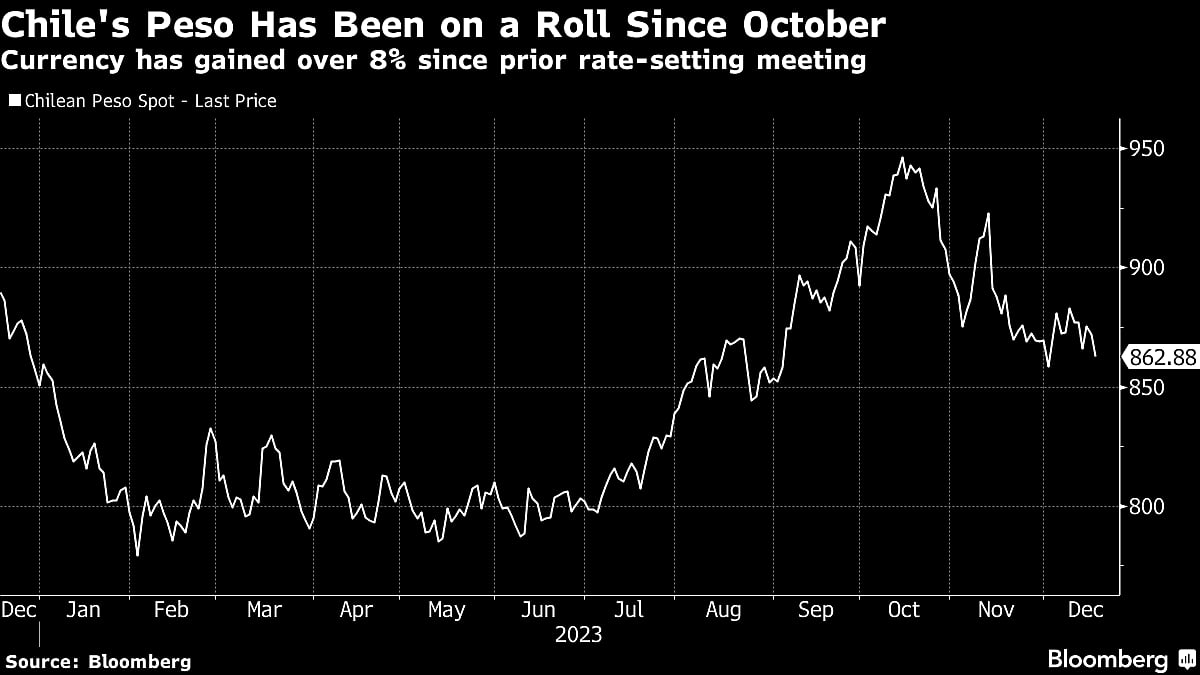Chile Speeds Up Pace Of Interest Rate Cuts After Currency Rebounds
Policymakers led by Rosanna Costa voted unanimously to cut borrowing costs to 8.25% late on Tuesday, as expected by 12 of 20 analysts in a Bloomberg survey.

(Bloomberg) -- Chile’s central bank sped up the pace of its interest rate cuts with a reduction of three quarters of a percentage point and signaled borrowing costs could fall even faster as both inflation and the global economy improve.
Policymakers led by Rosanna Costa voted unanimously to cut borrowing costs to 8.25% late on Tuesday, as expected by 12 of 20 analysts in a Bloomberg survey. Eight others expected a second straight reduction of 50 basis points.
In a statement, board members wrote that closely-watched core inflation — which excludes volatile items — is slowing faster than previously expected and reaffirmed the headline figure will hit the 3% target in the second half of next year. Meanwhile, global financial conditions have evolved favorably.
“The convergence of inflation to the target will require further cuts in the monetary policy rate,” policymakers wrote in the statement accompanying the decision. “Its magnitude and timing will take into account the evolution of the macroeconomic scenario and its implications for the trajectory of inflation.”

The bank delivered a more aggressive rate cut after the peso gained 8% since its prior meeting on Oct. 26, dragging down the cost of imports including fuels. Economic activity fell in October, according to a central bank proxy for GDP, while the end of a push for a new constitution is providing relief in the near-term. Globally, falling US Treasury yields are supporting asset prices.

What Bloomberg Economics Says
“December’s rate cut and updated inflation forecasts suggest Chile’s central bank will maintain a quick easing pace early next year. Monetary conditions remain tight and, with weak domestic demand and high unemployment, there’s plenty of room to continue cutting.”
— Felipe Hernandez, Latin America economist
— Click here for full report
While annual inflation slowed much less than forecast in November, to 4.8%, it nevertheless reached the lowest level since August 2021, according to the national statistics agency.
In the statement, central bankers wrote that inflation exceeded expectations last month “mainly due to the behavior of some volatile prices, which is considered less informative about inflationary trends.” Core inflation will slow to 3% in the first half of 2024, quicker than forecast in September, they wrote.
Read more: Chile Inflation Exceeds All Forecasts Ahead of Rate Decision
“They struck a dovish tone on inflation and played down the November report,” said Sebastian Diaz, an economist at Pacifico Research. “Rates continue to be very high. At the start of the year, the central bank will again accelerate the pace of cuts.”
Positive Reaction
Chile’s economy slipped 0.1% on the month in October amid a plunge in mining, according to the central bank. Still, commerce gained 1.6%, while services increased 0.6%, providing evidence that demand is stabilizing.
Analysts surveyed by Bloomberg see the nation’s GDP shrinking by 0.1% this year, joining Argentina and Peru in an economic contraction. Still, they see Chile’s growth hitting 2% in 2024, above the regional average.
In their statement, policymakers wrote Chile’s job creation remains slow and labor demand is still tepid. While investment continues to be weak, private consumption has shown “an incipient increase,” they wrote.
“The easing of inflation and slow economic growth are the main trends guiding the central bank’s decisions,” said Cristian Araya, chief strategist at Sartor Finance Group. “The decision should generate a positive reaction in financial assets, boosting appetite for instruments with higher risk, like longer-term bonds and stocks.”
The central bank will publish its latest economic forecasts in its quarterly monetary policy report early on Wednesday.

On Tuesday, board members wrote global inflation has slowed and the outlook for monetary policy has tended to ease, particularly in the US. In both local and international markets, there has been a reversal of the tighter financial conditions observed at the time of Chile’s October rate meeting, they wrote.
“The central bank can opt to maintain the pace of 75-basis point cuts in several future meetings or accelerate the pace to 100 basis points as soon as the next gathering in January, as long as inflation permits,” said Samuel Carrasco, a senior economist at Credicorp Capital. “For now, we maintain our estimate of the key rate nearing 5% at the end of 2024.”
--With assistance from Giovanna Serafim.
(Re-casts story, adds details from central bank statement and economist quotes starting in third paragraph)
More stories like this are available on bloomberg.com
©2023 Bloomberg L.P.